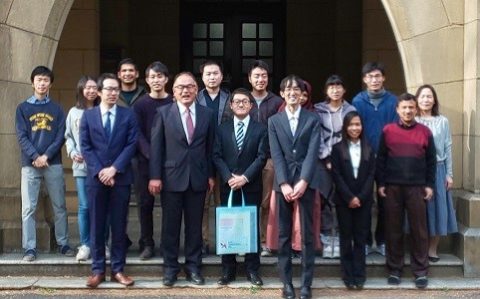Toru FUJIWARA, Professor
・Cross-Appointed Faculty, International Program in Agricultural Development Studies (IPADS)
Laboratory of Plant Nutrition and Fertilizers,
Department of Applied Biological Chemistry, Graduate School of Agricultural and Life Sciences, The University of Tokyo

http://park.itc.u-tokyo.ac.jp/syokuei/index_e.html
Contact information
Phone +81 3-5841-5104
>>EMAIL atorufu[at]g.ecc.u-tokyo.ac.jp
Professional Experience & Education
| 2010-Present: | Professor, Graduate School of Agricultural and Life Sciences, The University of Tokyo |
|---|---|
| 2003-2010: | Associate Professor, Biotechnology Research Center, The University of Tokyo |
| 1992-2003: | Assistant Professor, Faculty of Agriculture, The University of Tokyo |
| 1998-2001 2002-2005: | PRESTO researcher, JST |
| 1993-1994: | Visiting Scientist, Cornell University |
| 1992-1993: | Visiting Scientist, University of California, Davis |
| 1992: | Ph. D., the Faculty of Agriculture, the University of Tokyo |
| 1989-1991: | Visiting Scholar, Washington University St. Louis |
Discipline(s)
Plant Nutrition, Plant Nutrient Response, Crop Production with Low Fertilizers
Research interests
My major interests are to contribute to the low input agriculture. Mineral nutrients are among the requirements for crop production and fertilization contributed yield increase in the recent years. Fertilization, however, is not sustainable. It has impacts on environments and utilizes limited resources and high energies. My research extends from basic to applied sciences aiming to contribution to low input agriculture.
In the long history of plant evolution, plants experienced low nutrient environments and modern plants acquired the capacity to adapt low nutrient environments. This capacity is essential for crop production. Understanding such mechanisms of plants will contribute to the future developments of crops which require less fertilization for production. Such understanding of plant responses to low nutrient environments are also important as a basic scientific knowledge to understand plant behaviors.
To achieve the goal, we utilizes wide ranges of disciplines and technologies, including plant physiology, biochemistry, molecular biology, genetics, mathematics, information technologies.
Study example
- Studies on plant mechanisms to respond to different nutritional conditions: Using our stocks of cultivars and mutant lines, mechanisms of plant response to different nutritional conditions will be studied through molecular genetics, plant physiology etc.
- Studies on modeling of plant growth: In combination of phenotyping in fields or in labs of a number of plants/cultivars, in combination of genetic and/or elemental and metabolic profiles, we have been developing technology to determine/predict physiological conditions of plants and their growth. This relatively new technology allows a better prediction of crop growth and it would be very useful to expand this technology to a wide range of crops and conditions.
- Studies on breeding low-nutrient tolerant/high production crops: we have several collaborations with academic and commercial institutions to develop crop species tolerant to low nutrient conditions, through field testing and genetic analysis. Nutrient deficiencies of mineral nutrients are problems in various courtiers including Japan and development of such cultivars will contribute to stable production and income of farmers.
■Major publications
- Genome-wide analysis of long intergenic noncoding RNAs responding to low-nutrient conditions in Arabidopsis thaliana – possible involvement of trans-acting siRNA3 in response to low nitrogen.
Fukuda M, Nishida S, Kakei Y, Shimada Y, and Fujiwara, T. Plant Cell Physiol. (2019) doi: 10.1093/pcp/pcz048
- Proteasomal degradation of BRAHMA promotes Boron tolerance in Arabidopsis
Sakamoto, T., Tsujimoto-Inui, Y.,Sotta, N., Hirakawa, T., M. Matsunaga, T., Fukao, F., Matsunaga, S. and Fujiwara, T. Nature Communications (2018)
https://www.nature.com/articles/s41467-018-07393-6
- Establishment of genetically encoded biosensors for cytosolic boric acid in plant cells
Fukuda, M., Wakuta, S., Kamiyo, J. Fujiwara, T. and Takano J. Plant J 95 763-774 (2018)
- LjMOT1, a high-affinity molybdate transporter from Lotus japonicus, is essential for molybdate uptake, but not for the delivery to nodules.
Duan G, Hakoyama T, Kamiya T, Fujiwara T. Plant J. 90:1108-1119 (2017)
- Genome-wide analysis of specific alterations in transcript structure and accumulation caused by nutrient deficiencies in Arabidopsis thaliana
Nishida S, Kakei Y, Shimada Y, Fujiwara T. Plant J 91:741-753 (2017)
- Rapid transporter regulation prevents substrate flow traffic jams in boron transport.
Sotta N, Duncan S, Tanaka M, Sato T, Marée AF, Fujiwara T, Grieneisen VA. eLife, 6 :e27038 (2017)
- Role of LOTR1 in nutrient transport through organization of spatial distribution of root endodermal barriers.
Li*, B., Kamiya*, T. , Kalmbach, L., Yamagami, M., Yamaguchi, K., Shuji, S., Sawa, S., Danku, J.M.C, Salt, D.E., Geldner, N., and Fujiwara, T *Equally contributed.
Curr. Biol.27: 1-8 (2017) DOI: 10.1016/j.cub.2017.01.030
- The Minimum Open Reading Frame, AUG-Stop, Induces Boron-Dependent Ribosome Stalling and mRNA Degradation
Tanaka, M., Sotta, N., Yamazumi, Y., Yamashita, Y., Miwa, K., Murota, K., Chiba, Y., Hirai, MY., Akiyama, T., Onouchi, H., Naito, S. and Fujiwara, T. Plant Cell tpc.00481.2016. (2016)
- Phosphate treatment selectively inhibits new arbuscule development in mycorrhizal rice roots
Kobae, Y., Ohmori, Y., Saito, C. and Fujiwara, T. Plant Physiology 171(1):566-79 (2016) DOI: 10.1104/pp.16.00127
- The MYB36 transcription factor orchestrates Casparian strip formation.
Kamiya, T., Borghi, M., Wang, P., Danku, J. M., Kalmbach, L., Hosmani, PS., Naseer, S., Fujiwara, T, Geldner, N. and Salt, DE. Proc. Natl. Acad. Sci. USA doi: 10.1073/pnas.1507691112 (2015)
- Mathematical modeling and experimental validation of the spatial distribution of boron in the root of Arabidopsis thaliana identify high boron accumulation in the tip and predict a distinct root tip uptake function.
Shimotohno A*., Sotta N*., Sato T., De Ruvo M., Maree AF., Grieneisen VA*. and Fujiwara, T.* Plant Cell Physiol. 56:620-630 (2015)
- Roles of BOR2, a Boron Exporter, in Cross Linking of Rhamnogalacturonan II and Root Elongation under Boron Limitation in Arabidopsis
Miwa K, Wakuta S, Takada S, Ide K, Takano J, Naito S, Omori H, Matsunaga T, Fujiwara T.* Plant Physiology 163: 1699–1709 (2013)
- Low-affinity cation transporter (OsLCT1) regulates cadmium transport into rice grains
Uraguchi S, Kamiya T, Sakamoto T, Kasai K, Sato Y, Nagamura Y, Yoshida A, Kyozuka J, Ishikawa S, Fujiwara T.* Proc. Natl. Acad. Sci. USA 108: 20959–20964 (2011)
- Boron dependent degradation of NIP5;1 mRNA for acclimation to excess boron conditions
Tanaka M, Takano J, Chiba Y, Lombardo F, Ogasawara Y, Onouchi H, Naito S, Fujiwara T.* Plant Cell 23: 3547–3559 (2011)
- Condensin II alleviates DNA damage and is essential for tolerance of B overload stress in Arabidopsis thaliana
Sakamoto T, Tsujimoto-Inui Y, Uraguchi S, Yoshizumi T, Matsunaga S, Mastui M, Umeda M, Fukui K, Fujiwara T.* Plant Cell 23:3533–3546 (2011)
- Polar localization and degradation of Arabidopsis boron transporters through distinct trafficking pathways.
Takano J, Tanaka M, Toyoda A, Miwa K, Kasai K, Fuji K, Onouchi H, Naito S, Fujiwara T. Proc. Natl. Acad. Sci. USA 107:5220-5225 (2010)
- NIP1;1, an aquaporin homolog, determines the arsenite sensitivity of Arabidopsis thaliana.
Kamiya T, Tanaka M, Mitani N, Ma JF, Maeshima M, Fujiwara T.* J. Biol. Chem. 284: 2114-2120 (2009)
- Highly boron deficiency-tolerant plants generated by enhanced expression of NIP5;1, a boric acid channel
Kato Y, Miwa K, Takano J, Wada M, Fujiwara T.* Plant Cell Physiol. 50: 58-66 (2009)
- NIP6;1 is a boric acid channel for preferential transport of boron to growing shoot tissues in Arabidopsis thaliana.
Tanaka M, Wallace I, Takano J, Roberts RM, Fujiwara T.* Plant Cell 20:2860-2875 (2008)
- Plants tolerant of high boron levels.
Miwa K, Takano J, Omori H, Seki M, Shonozaki K, Fujiwara T.* Science 318:1417 (2007)
- An Arabidopsis thaliana high-affinity molybdate transporter required for efficient uptake of molybdate from soil.
Tomatsu H, Takano J, Takahashi H, Watanabe-Takahashi A, Shibagaki N, Fujiwara, T.* Proc. Natl. Acad. Sci. USA 104: 18807–18812 (2007)
- Cell-type specificity of the expression of Os BOR1, a rice efflux boron transporter gene, is regulated in response to boron availability for efficient boron uptake and xylem loading.
Nakagawa Y, Hanaoka H, Kobayashi M, Miyoshi K, Miwa K, Fujiwara T.* Plant Cell 19: 2624–2635 (2007)
- Improvement of seed yields under boron-limiting conditions through overexpression of BOR1, a boron transporter for xylem loading, in Arabidopsis thaliana
Miwa K, Takano J, Fujiwara T.* Plant J. 46: 1084-1091 (2006)
- Endocytosis and degradation of BOR1, a boron transporter of Arabidopsis thaliana, regulated by boron availability
Takano J, Miwa K, Yuan L, von Wire´n N, Fujiwara T.* Proc. Natl. Acad. Sci. USA 102: 12276–12281 (2005)
- Isolation and characterization of an Arabidopsis mutant that overaccumulates O-Acetyl-L-Ser
Ohkama-Ohtsu N, Kasajima I, Fujiwara T*, Naito S. Plant Physiol. 136: 3209-3222 (2004)
- Arabidopsis boron transporter for xylem loading.
Takano J, Noguchi K, Yasumori M, Kobayashi M, Gajdos Z, Miwa K, Hayashi H, Yoneyama T, Fujiwara T.* Nature 420: 337-340 (2002)
- Role of O-acetyl-L-serine in the coordinated regulation of the expression of a soybean seed storage protein gene by sulfur and nitrogen nutrition.
Kim H, Hirai MY, Hayashi H, Chino M, Naito S, Fujiwara T.* Planta 209: 282-289 (1999)
- Detection of several mRNA species in rice phloem sap.
Sasaki T, Chino M, Hayashi H, Fujiwara T.* Plant Cell Physiol. 39: 895-897 (1998)
- bor1-1, an Arabidopsis thaliana mutant that requires a high level of boron.
Noguchi K, Yasumori M, Imai T, Naito S, Matsunaga T, Oda H, Hayashi H, Chino M, Fujiwara T.* Plant Physiol. 115:901-906 (1997)
- Tissue-specific and temporal regulation of a β-conglycinin gene: roles of the RY repeat and other cis-acting elements.
Fujiwara T, Beachy RN. Plant Mol. Biol. 24: 261-272 (1994)
- Cell-to-cell trafficking of macromolecules through plasmodesmata potentiated by the red clover necrotic mosaic virus movement protein.
Fujiwara T, Giesman-Cookmeyer D, Ding B, Lommel SA, Lucas WJ. Plant Cell 5: 1783-1794 (1993)
- Reversible inactivation of the nopaline synthase gene by double transformation.
Fujiwara T, Lessard PA, Beachy RN Plant Cell Rep. 13: 133-138 (1993)
- Expression of soybean seed storage protein genes in transgenic plants; their effects on expression of a neighboring gene and position dependency.
Fujiwara T, Beachy RN Plant Cell Physiol. 34: 13-20 (1993)
- Seed specific repression of GUS activity in tobacco plants by antisense RNA.
Fujiwara T, Lessard PA, Beachy RN Plant Mol. Biol. 20: 1059-1069 (1992)
- Effects of sulfur nutrition on expression of the soybean storage protein genes in transgenic petunia.
Fujiwara T, Hirai-Yokota M, Chino M, Komeda Y, Naito S. Plant Physiol. 99: 263-268 (1992)

<Crop testing in a field in Kenya (2019)>

<Photo of lab members after graduation ceremony (2019)>